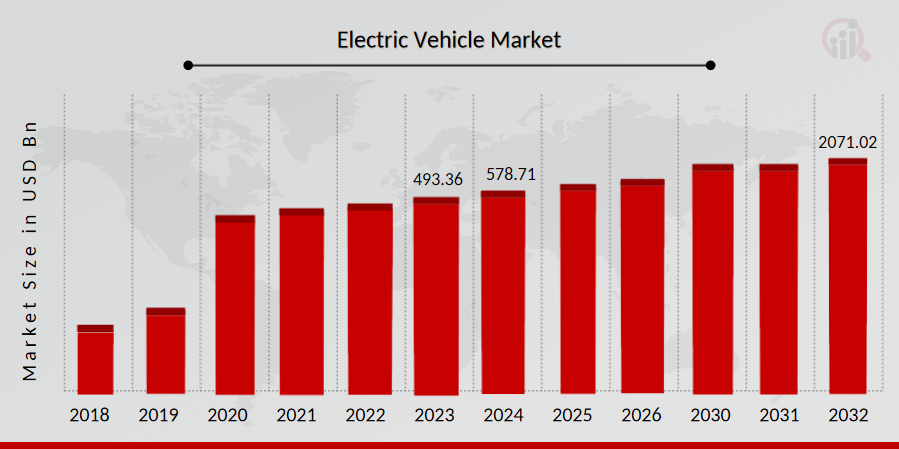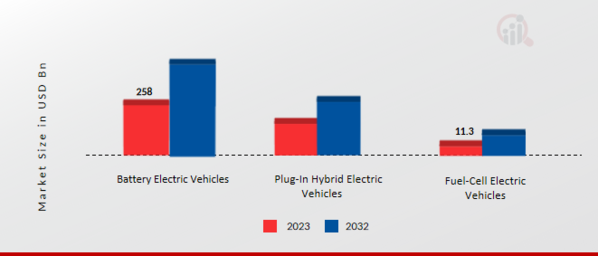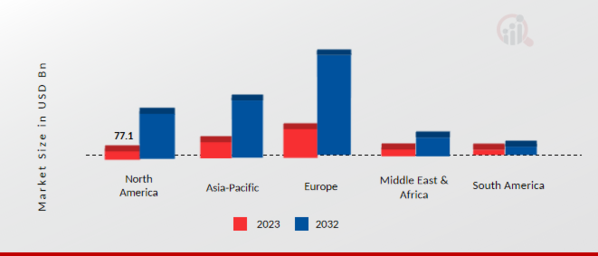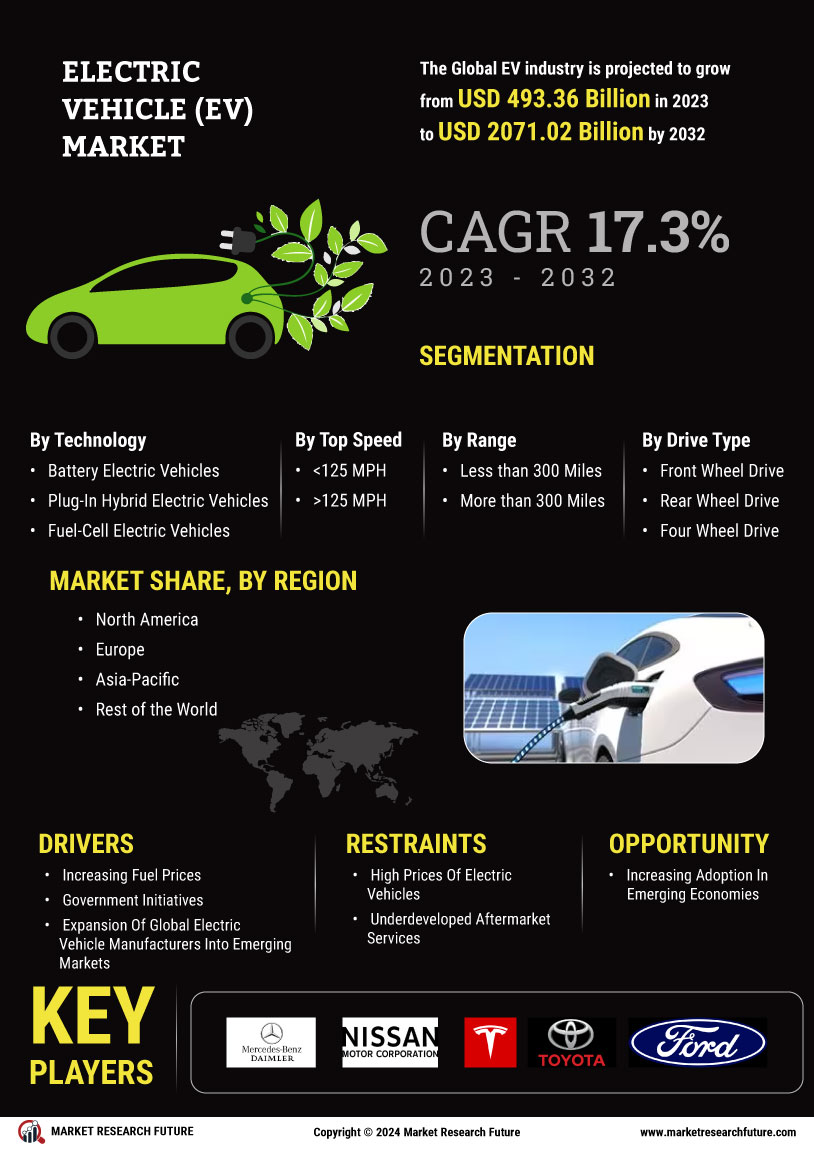Electric Vehicle (EV) Market Overview
The global electric vehicle market industry is projected to grow from USD 578.71 billion in 2024 to USD 2071.02 billion by 2032, exhibiting a compound annual growth rate (CAGR) of 17.27% during the forecast period (2024–2032). EV market size was valued at USD 493.36 billion in 2023, expected to be driven by key factors such as increasing fuel prices, government initiatives, and the expansion of global electric car manufacturers into emerging electric vehicles market.
However, factors such as high EV prices and underdeveloped aftermarket services are expected to restrict electric vehicle market growth. On the other hand, the increasing adoption in emerging economies pose lucrative opportunities for the global electric vehicle market.

Source: Secondary Research, Primary Research, MRFR Database, and Analyst Review
EV Market Opportunity
Increasing Fuel Prices
The decrease in supply and availability of crude oil is fluctuating pricing strategies owing to geopolitical tensions. Furthermore, the uneven taxation policies that differ from country to country and region to region affect the pricing policies. Due to these factors, a large segment of the population is shifting their preference towards electric transportation. In the last few years, the demand for electric cars in the US has been rapidly increasing and has witnessed a 70% year-over-year growth in sales. Furthermore, along with the US, Norway has also taken a step ahead and shifted more focus towards electric transportation. Thus, the increasing fuel prices and growing popularity of electric transportation are expected to drive the growth of the electric vehicle market during the forecast period.
As per the International Energy Agency (IEA), the share of electric cars in total sales has more than tripled in three years, from around 4% in 2020 to 14% in 2022. The cost of fuel is a significant factor in the decision-making process of consumers when purchasing a vehicle. As fuel prices continue to rise, consumers are looking for alternatives to traditional gasoline-powered vehicles, and EVs are becoming a more attractive option.
In addition, government policies, the Tesla effect, lower battery costs, 5G rollouts, and the launch of the EV charging infrastructure are other drivers of the electric vehicle market. China is leading the charge in the market, with new EV sales growing by 82% in 2022, accounting for nearly 60% of global EV purchases. The United States is also expected to see a significant increase in EV sales, with S&P Global Mobility forecasting that electric transportation sales in the United States could reach 40% of total passenger car sales by 2030.
According to a study by the International Energy Agency (IEA), as of 2021, the global average gasoline price was approximately $1.20 per liter, and the average diesel price was around $1.28 per liter. These prices can significantly impact the running costs of traditional vehicles. In regions with high fuel prices, there has been a noticeable surge in electric transportation sales. For example, in countries like Norway, where fuel prices are comparatively high, electric cars account for a significant share of new car sales.
EV Market Technology Segment Insights
Electric Vehicle Technology Insights
Based on technology, the electric vehicle market segmentation includes battery-electric transportation, plug-in hybrid electric vehicles, and fuel-cell EV. The battery electric transportation segment held the majority share in 2022, contributing around ~70.1% to the electric vehicle market revenue. battery electric vehicles (BEVs), use a battery pack to store the electrical energy that powers the motor. The batteries are charged by plugging the vehicle in to an electric power source.
Although electricity production may contribute to air pollution, the U.S. Environmental Protection Agency categorizes electric vehicles for all-electric transportation as zero-emission vehicles because they produce no direct exhaust or tailpipe emissions locally. Both heavy-duty and light-duty all-electric transportation are commercially available. BEVs are typically more expensive than similar conventional and hybrid vehicles, although some of the cost can be recovered through fuel savings, a federal tax credit, or state incentives.
Figure2: Electric Vehicle (EV) Market by Component, 2022 & 2032 (USD Billion)

Source: Secondary Research, Primary Research, MRFR Database, and Analyst Review
Electric Vehicle (EV) Market Vehicle Top Speed Segment Insights:
Electric Vehicle Top Speed Insights
Based on top speed, the electric transportation and electric car technology market segmentation includes <125 MPH and >125 MPH. The >125 MPH segment held the majority share in 2022, contributing around ~58.8% to the electric vehicle market revenue. Vehicles with top speeds exceeding 125 MPH hold a slightly larger electric vehicle market share than those below 125 MPH, and vehicles with a range greater than 300 miles hold a larger share than those below 300 miles.
Electric Vehicle (EV) Market Range Segment Insights:
EVs Range Insights
Based on the range, the electric vehicle market segmentation includes less than 300 miles and more than 300 miles. By range, more than 300-mile segment will hold the majority of the electric vehicle market share in 2022, contributing 59.5% of the electric vehicle market share. According to the United States Department of Energy, the number of EVs offering at least 300 miles of range has grown tremendously since 2016 and has tripled in 2022 compared to a year prior. higher range remains a huge selling point for US consumers.
Electric Vehicle (EV) Market Vehicle Drive Type Segment Insights:
EV Drive Type Insights
Based on the vehicle drive type, the electric vehicle market segmentation includes front-wheel drive, rear-wheel drive, four-wheel drive, and all-wheel drive. By vehicle drive type, the wheel drive segment will hold the majority market share in 2022, contributing 51.0% of the electric vehicle market share. Front wheel drive (FWD) means that the power from the engine is delivered to the front wheels. With FWD, the front wheels are pulling while the rear wheels don’t receive any power. The pros of a FWD vehicle are that it typically has better fuel economy. Since the weight of the engine is located above the driving wheels, a FWD vehicle can maintain better traction in the snow.
However, performance enthusiasts have claimed FWD vehicles are less fun to drive. Rear wheel drive (RWD) means that engine power is delivered to the rear wheels, which in turn push the car forward. The front wheels do not receive any power. Since the weight of a RWD vehicle is more evenly distributed than in many front wheel drive vehicles, there’s a better balance of weight. This is why most sports cars, such as the Corvette and Camaro, are RWD and more exciting to drive. The disadvantage of a RWD vehicle is that they do not perform well in poor weather conditions, such as rain or snow, because they are more prone to traction-loss.
Electric Vehicle (EV) Market End Use Segment Insights:
EV End Use Insights
Based on the End Use, the Electric Vehicle Market segmentation includes Private and Commercial Fleets. By end use, the private segment will hold the majority market share in 2022, contributing 63.0% of the market share. Privately owned vehicles hold a larger electric vehicle market share compared to commercial fleets, and passenger cars are the most popular vehicle type, followed by two & three-wheelers, commercial vehicles, and Off-Highway vehicles. This rapid growth is driven by factors such as government incentives, falling battery costs, and increasing consumer awareness of the environmental benefits of EVs.
Electric Vehicle (EV) Market Vertical Segment Insights:
EV Type Insights
Based on the type, the electric vehicle market segmentation includes passenger cars, commercial vehicles, Electric Two Wheelers & three-wheelers, and off-highway vehicles. By type, the car segment will hold the majority EV market share in 2022, contributing 56.0% of the market share. A passenger car is a multi-track vehicle with at least two axles, its own driver and usually four wheels. It is primarily intended for passenger transportation. Most passenger cars are road vehicles used in public road transport. Buses and trucks are not considered passenger cars; they are considered commercial vehicles.
Together with the driver’s seat, a passenger car may have a maximum of 9 seats if the design and equipment allow it. The number of people who may be transported depends on the number of safety belts installed. The passenger car, including the items loaded on it, may not weigh more than 3.5 tons. To be allowed to drive a passenger car in public road traffic, a driver’s license and vehicle registration are required.
EV Regional Insights
By region, the study provides electric vehicle market insights into North America, Europe, Asia-Pacific, the Middle East & Africa, and South America. In terms of revenue, Asia Pacific held the largest share of 55.8% in the electric vehicle market in 2022 and is expected to maintain its dominance during the forecast period. Asia Pacific is the largest market for electric car technology. The region is home to some of the fastest-developing economies, such as China and India.
The governments of these emerging economies have recognized the growth potential of electric vehicle market trends and, hence, have taken different initiatives to attract major OEMs to manufacture electric cars in domestic markets. The region is home to 93 of the worlds most polluted cities, and has a high energy demand. As of 2022, the transportation sector in the region accounts for around 14% of overall emissions.
Thus, countries in the region, are planning to reduce emissions in the coming years. China, the e-mobility leader in the region, had set a target of over 20% EV sales by 2025, which it had already achieved in 2022 and is expected to have around 35% in 2023. Similarly, countries such as South Korea, Japan and India have also announced plans to shift to EVs in coming years. India, for instance, plans to have 30% of its passenger car sales be electric by 2030.
South Korea and Japan are also aiming to be among the world's top 5 EV producers by 2030. China is also investing significantly in the production of both electric passenger vehicles and commercial vehicles, with plans for export. OEMs such as BYD plan to open plants in other parts of the world to manufacture electric buses and electric trucks to meet regional demand. The country supports EV usage by offering a subsidy for buying EVs. The country is also encouraging manufacturers to develop better EV technology. Various EV charging stations are set up across the country due to the subsidy for setting up EV infrastructure. Further, the major countries studied in the electric vehicle market report are the U.S., Canada, Germany, France, the UK, Italy, Spain, China, Japan, India, Australia, South Korea, and Brazil.
Figure3: Electric Vehicle (EV) Market Size By Region 2023 & 2032

Source: Secondary Research, Primary Research, MRFR Database, and Analyst Review
Electric Vehicle (EV) Key Market Players & Competitive Insights
With a strong presence across different verticals and geographies, the electric vehicle market is highly competitive and dominated by established, pure-play vendors. Over 30 vendors cater to this electric vehicle market, and they continually innovate their solutions to meet the evolving needs of businesses by adopting new technologies to make business more effective. These vendors have a robust geographic footprint and partner ecosystem to cater to diverse customer segments. The electric vehicle market is highly competitive, with many vendors offering similar products and services.
The major players in the electric vehicle market include Daimler AG, Nissan Motor Corporation, Tesla, Inc., Toyota Motor Corporation, Ford Motor Company, Volkswagen, BMW, General Motors, Hyundai Motor Company, Mitsubishi Motors Corporation, and BYD Motors Inc. Tesla, Inc. is aggressive in manufacturing and broadening its electric vehicle market share in the EV market. It aims to accelerate the world towards sustainable energy and has initiated innovation in the automobile industry as a niche differentiator, offering market-disrupting products in the form of luxury electric cars.
Additionally, Tesla’s broad differentiation strategy is a long-term play, focusing on electric automobile automation, battery technology, and environmentally friendly products such as solar roof tiles. Furthermore, the company aims to expand its electric vehicle market reach to add more customers. For instance, Tesla has registered their first office in Bengaluru, India and planning to expand its business operations in Delhi, Mumbai, and Bengaluru by opening up showrooms. The electric vehicle market is a consolidated market due to increasing competition, acquisitions, mergers, and other strategic electric vehicle market developments and decisions to improve operational effectiveness.
Key companies in the electric vehicle (EV) market include:
- Daimler AG
- Nissan Motor Corporation
- Tesla, Inc.
- Toyota Motor Corporation
- Ford Motor Company
- Volkswagen
- BMW
- General Motors
- Hyundai Motor Company
- Mitsubishi Motors Corporation
- BYD Motors Inc.
- Tesla, Inc.
Electric Vehicle (EV) Industry Developments
April 2024: Recently, BYD's new all-electric car, the SEAGULL, made its official debut in Colombia. Local customers have been eagerly awaiting the BYD SEAGULL since its introduction at the Colombia Auto Show last year. With its sleek appearance, state-of-the-art electric features, and great value for money, this little electric hatchback is sure to become the preferred vehicle for young urban Colombians. More than 600 media representatives and customers attended the launch event, which received praise from the local press for being Colombia's premier new product launch each year.
According to Li Nan, Deputy General Manager of BYD America Auto Sales Division, "BYD has been committed to advancing the development of electric mobility since joining the automotive industry in 2003." With total sales of over 7 million vehicles worldwide, BYD has emerged as the market leader in the world for new energy vehicles. In the future, we hope to provide customers with even more dependable and high-quality products. More young Colombians will be able to purchase their first battery-electric car thanks to the launch of the BYD SEAGULL."
"The Colombian automotive market faces significant challenges in 2024," said Marco Pastrana, general manager of Motorysa, BYD's partner in Colombia. In spite of these obstacles, BYD has seen an astounding 31% increase in sales. BYD has continuously led the market in new energy passenger vehicle sales since entering Colombia. The BYD SEAGULL's introduction is expected to strengthen Colombia's stance on environmentally friendly transportation, demonstrating the nation's readiness to embrace the future of electric mobility."
January 2023: Once a longshot startup, Tesla grew to become the largest manufacturing employer in the state and the leading manufacturer of electric vehicles worldwide in just 20 years since its founding in San Carlos, California. Over the past ten years, the US has lost a lot of manufacturing jobs, and global supply chains have been shaken up, but Tesla has defied the trend by increasing employment and production in the US. The employment in California that was fueled by Tesla increased by 40% between 2018 and 2021, and the state's wages that year exceeded the national average by 50%, offering the highest compensation in our industries.
Over 80,000 direct and indirect jobs in California were supported by Tesla in 2021. Of these, more than 43,000 were the result of spending $1.6 billion with suppliers in California. For every 100 direct Tesla jobs, the supply chain supported an additional 50 jobs, and subsequent consumer activity supported an additional 68 jobs. Tesla paid $1 billion in federal, state, and local taxes on average between 2018 and 2021; in 2021, state and local taxes accounted for about $400 million of the total. Between 2018 and 2021, Tesla's average share of the state's gross state product (GSP) increased by 42%, outpacing the state's GSP growth of 16%. $16.6 billion in economic activity, or $44.4 million every day, was generated by the wages of Tesla and jobs related to Tesla.
Electric Vehicle Market Segmentation
Global EV Technology Outlook
- Battery-electric vehicles
- Plug-In Hybrid Electric Vehicles
- Fuel-Cell Electric Vehicles
EV Top Speed Outlook
EV Range Outlook
- Less than 300 Miles
- More than 300 Miles
EV Drive Type Outlook
- Front Wheel Drive
- Rear Wheel Drive
- Four Wheel Drive
- All-wheel-drive
EV End Use Outlook
- Private
- Commercial Fleets
EV Type Outlook
- Passenger Cars
- Commercial Vehicles
- LCVs
- Trucks
- Buses & Coaches
- Two & Three Wheelers
- Off-Highway Vehicles
EV Regional Outlook
North America
Europe
- UK
- Germany
- France
- Italy
- Spain
- Norway
- Netherlands
- Sweden
- Finland
- Rest of Europe
Asia-Pacific
- China
- Japan
- India
- South Korea
- Thailand
- Taiwan
- Malaysia
- Vietnam
- Rest of Asia-Pacific
Middle East & Africa
- Saudi Arabia
- UAE
- Jordon
- Rest of Middle East & Africa
South America
- Brazil
- Argentina
- Chile
- Colombia
- Rest of South America
| Report Attribute/Metric |
Details |
| Market Size 2023 |
USD 493.36 Billion |
| Market Size 2024 |
USD 578.71 Billion |
| Market Size 2032 |
USD 2071.02 Billion |
| Compound Annual Growth Rate (CAGR) |
17.27 % (2024-2032) |
| Base Year |
2023 |
| Market Forecast Period |
2024-2032 |
| Historical Data |
2018- 2022 |
| Market Forecast Units |
Value (USD Billion) |
| Report Coverage |
Revenue Forecast, Market Competitive Landscape, Growth Factors, and Trends |
| Segments Covered |
technology, top speed, range, vehicle drive type, end-use, and vehicle type and Region |
| Geographies Covered |
Europe, North America, Asia-Pacific, Middle East & Africa, and South America |
| Countries Covered |
The U.S, Germany, Canada, U.K., Italy, France, Spain, Japan, China, Australia, India, South Korea, Brazil, and others. |
| Key Companies Profiled |
Daimler AG, Nissan Motor Corporation, Tesla, Inc., Toyota Motor Corporation, Ford Motor Company, Volkswagen, BMW, General Motors, Hyundai Motor Company, Mitsubishi Motors Corporation, and BYD Motors Inc. Tesla, Inc. |
| Key Market Opportunities |
Increasing adoption in emerging economies |
| Key Market Dynamics |
Increasing fuel prices; Government initiatives· Expansion of global electric vehicle manufacturers into emerging markets |
Electric Vehicles Market Highlights:
Frequently Asked Questions (FAQ) :
The Electric Vehicle Market size is expected to be valued at USD 368.2 Billion in 2022.
The global market is projected to grow at a CAGR of 17.3% during the forecast period, 2024-2032.
Asia Pacific had the largest share of the global market.
The key players in the market are Daimler AG, Nissan Motor Corporation, Tesla, Inc., Toyota Motor Corporation, Ford Motor Company, Volkswagen, BMW, General Motors, Hyundai Motor Company, Mitsubishi Motors Corporation, and BYD Motors Inc. Tesla, Inc.
The Battery Electric Vehicles category dominated the market in 2022.






























